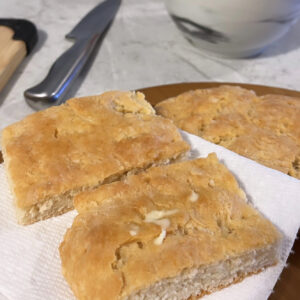
In many Haudenosaunee communities, waking up early for “No:ia” (new-ya) is something that provides fuel for an age-old tradition and a pick at sweets for breakfast.
For the traditional Haudenosaunee, the belief that the year does not renew until the ashes have been stirred in ceremony is still strongly upheld. However, many of our European neighbours rubbed off on us and hold similar customs in comparison to one another during the new year.
The Scottish celebrate a part of “Hogmanay” (hawg-man-ay) with First-Footing by running from house-to-house shortly after midnight to welcome the new year. After converting to Christianity the Irish placed a great importance on who was the first person in the door at the start of New Year’s Day and preferred a dark haired man to bring good fortune. The British would open their back door to let the old year free, and ask a dark haired man to come through the front door carrying coal, salt and bread at the stroke of midnight. But, it was the adaptation of our Dutch neighbours celebration of the new year roughly 400 years ago that simply stuck.
So what is No:ia you ask? “Gellukig Nieuwjaar” (gae-loo-hig new-yar) is how you say “Happy New Year” in Dutch, and the term “Nieuwjaar” is where the adapted word “No:ia” stems from.
Haudenosaunee ancestors saw Dutch children celebrating the turnover in their calendar cycle by aiming to be the first at a neighbour’s doorstep early on New Year’s Day. If this was performed, the children would be considered very lucky and rewarded with coin, fruits and Oliebollen. Oliebollen is a sweet, oil fried dumpling that is very, very similar to indian donut and might be where the pastry originated from. This trip of running from house-to-house had to be completed before noon and this piece of the Dutch celebrations has since been adapted and immortalized within Haudenosaunee communities.
Fast-forward 400 years and on New Year’s Day Haudenosaunee children (and adults) still visit their relatives and friends to holler “No:ia!” on their doorsteps. The visitors will then subsequently receive one of a variety of treats including; fruits, homemade indian donuts or cookies, and sometimes a jar of honey early in the morning.
It can be said that this practice was adapted because it falls perfectly in line with the cultural and moral basis of the Haudenosaunee. Celebrating No:ia in this way is a great form of reconnecting with old relatives and friends and it shows appreciation for familial connection. The sense of sharing falls directly into giving and offering food freely as a custom that has not been forgotten. As well, the smell of warm donuts and cookies is a keepsake many Haudenosaunee cherish in childhood memories.
Indian Cookies
1 cup butter or margarine, softened
2 cups brown sugar
1 egg, well-beaten
1 cup buttermilk
4 cups of flour
1 teaspoon of baking powder
1/2 teaspoon of baking soda
1/4 teaspoon of salt
1 teaspoon of nutmeg
Optional (but not really): 1/2 cup of Raisins.
In a large bowl blend butter or margarine, sugar, and egg with a wooden spoon. In a separate bowl, mix dry ingredients. Add dry ingredients to butter mixture alternately with buttermilk. Dough will be very stick. Add a little flour and roll out on a floured surface just until not sticky and then roll to about a half inch thick. Cut cookies into shapes with cutters. 350°F for 10-15 minutes.
Indian Donuts
3/4 cup granulated sugar and 3/4 cup brown sugar
4 tablespoons of butter, softened
1 1/2 cups of buttermilk
1 egg
6 cups of all-purpose flour
4 1/2 teaspoons of baking powder
3/4 teaspoon of salt
3/4 teaspoon of ground cinnamon
3/4 teaspoon of ground nutmeg
Optional: Raisins. Somewhere between 1/3 to 1/2 of a cup. Some say no. Some say yes. Ultimately they belong there. The choice is yours.
Canola oil or melted shortening for frying
In a large bowl first blend the sugar and softened butter. Once that is all together add the buttermilk and eggs and meld this into a goopy wet mixture. This is when you add in the raisins. (Do it.)
In another bowl blend together the dry ingredients: 3 cups all-purpose flour, baking powder, salt, cinnamon, and nutmeg. Slowly start to add the dry ingredients into the wet bowl. When that is all mixed together you have another three cups of flour to add into the dough just until you get it to the right consistency — similar to a biscuit dough. Too much flour and your donuts will be tough so be mindful.
On a lightly floured surface, roll out dough to 1/2-inch thickness. Use a doughnut cutter or for that real Nu-yah look use a doll shaped cutter.
Heat oil over medium heat. You’re going to want it to be about one inch deep. Bring the oil up to 375 degrees using a thermometer to monitor the temperature.
Don’t overcrowd your oil with donuts. Cook about 3-5 at a time depending on how big your pan is. Fry until browned all over about 90 seconds per side.
Remove cooked donuts and drain off excess oil on a tray covered in paper towels or on newspaper like the grammas used to use.











